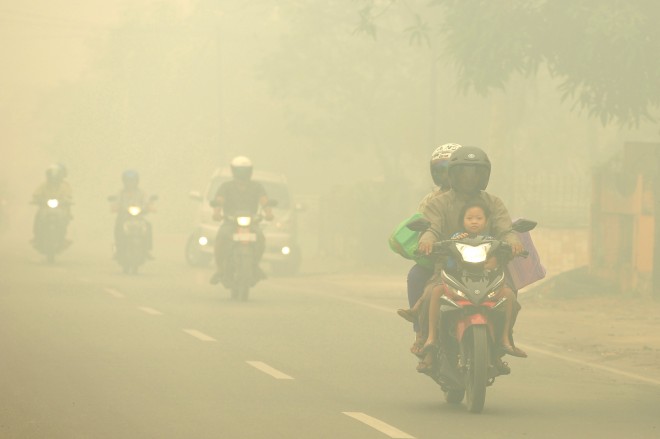Southeast Asian haze crisis killed over 100,000—study

Motorists ride on a road as thick haze from forest fires shroud the city in Palangkaraya, Central Borneo, Indonesia, Oct. 27, 2015. The haze blanketed parts of western Indonesia for about two months and affected neighboring countries like Singapore, Malaysia and Thailand. AP FILE PHOTO
JAKARTA, Indonesia – A smog outbreak in Southeast Asia last year may have caused over 100,000 premature deaths, according to a new study released Monday that triggered calls for action to tackle the “killer haze.”
Researchers from Harvard and Columbia universities in the US estimated there were more than 90,000 early deaths in Indonesia in areas closest to haze-belching fires, and several thousand more in neighboring Singapore and Malaysia.
The new estimate, reached using a complex analytical model, is far higher than the previous official death toll given by authorities of just 19 deaths in Indonesia.
“If nothing changes, this killer haze will carry on taking a terrible toll, year after year,” said Greenpeace Indonesia forest campaign Yuyun Indradi.
“Failure to act immediately to stem the loss of life would be a crime.”
Article continues after this advertisementA spokesman for Indonesia’s environment ministry did not immediately have any comment.
Article continues after this advertisementIndonesian authorities have previously insisted they are stepping up haze-fighting efforts, through such actions as banning the granting of new land for palm oil plantations and establishing an agency to restore devastated peatlands.
The haze is an annual problem caused by fires set in forest and on carbon-rich peatland in Indonesia to quickly and cheaply clear land for palm oil and pulpwood plantations.
The blazes occur mainly on Indonesia’s western Sumatra island and the Indonesian part of Borneo, with monsoon winds typically blowing the haze over Singapore and Malaysia.
But last year’s fires were among the worst in memory and cloaked large parts of the region in choking smog for weeks, causing huge numbers to fall ill and sending diplomatic tensions soaring.
The new study to be published in journal Environmental Research Letters, which combined satellite data with models of health impacts from smoke exposure and readings from pollution monitoring stations, estimated that 100,300 had died prematurely due to last year’s fires across the three countries.
They estimated there were 91,600 deaths in Indonesia, 6,500 in Malaysia and 2,200 in Singapore.
Infants at risk
Greenpeace hailed a “groundbreaking” study they said for the first time gave a detailed breakdown of deaths from last year’s fires, but cautioned that the figure was a “conservative estimate.”
It only looked at health impacts on adults and the effect of dangerous fine-particulate matter, known as PM 2.5. It did not examine the effect on youngsters or of the other toxins produced by the blazes.
In reality, infants are some of the most at risk from the haze, said Nursyam Ibrahim, from the West Kalimantan province branch of the Indonesian Medical Association on Borneo.
“We are the doctors who care for the vulnerable groups exposed to toxic smoke in every medical centre, and we know how awful it is to see the disease symptoms experienced by babies and children in our care,” said Ibrahim.
The study found an increase in the number of fires in peatland and in timber concessions in 2015, compared to the last haze outbreak considered major, in 2006, and that the number of fires in palm oil plantations fell.
Shannon Koplitz, a Harvard scientist who worked on the study, said she also hoped the model they had developed could help those involved with tackling the annual blazes make quick decisions “as extreme haze events are unfolding.”
Last year’s haze outbreak was the worst since 1997 due to a strong El Nino weather system, which created tinder-dry conditions in Indonesia and made peatland and forests more vulnerable to going up in flames./rga
RELATED STORIES
Indonesia steps up fire response as haze blankets Singapore